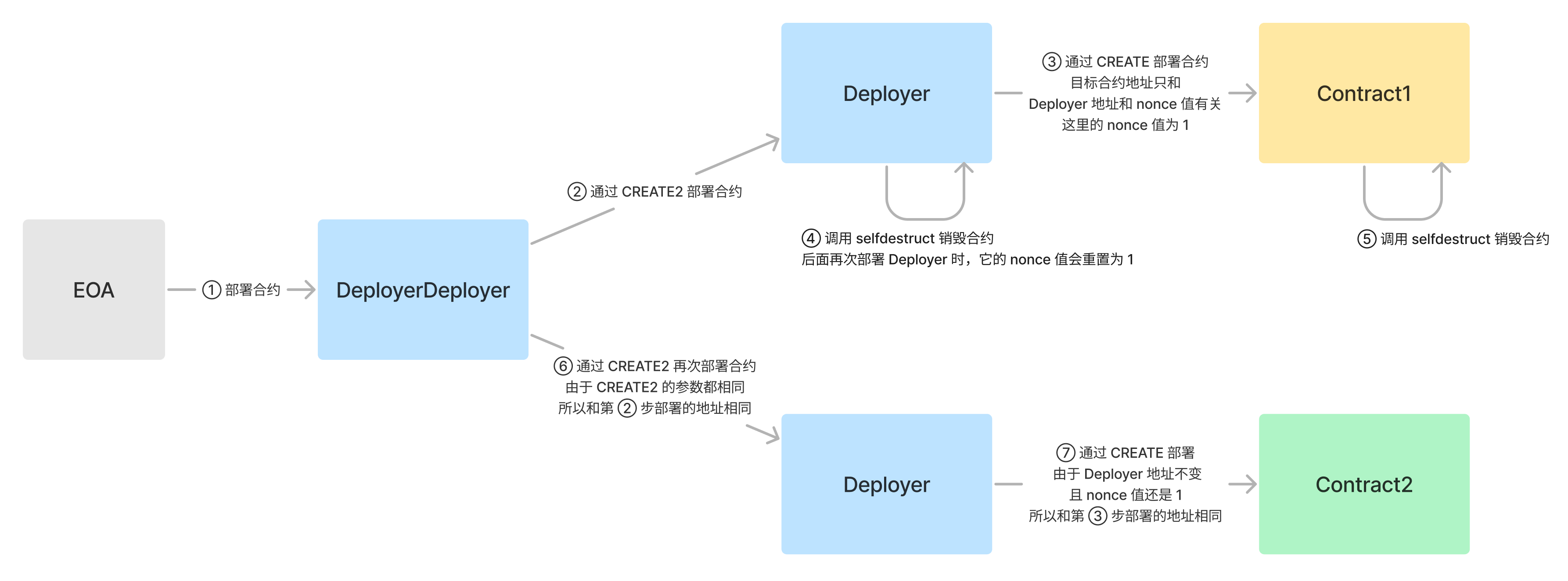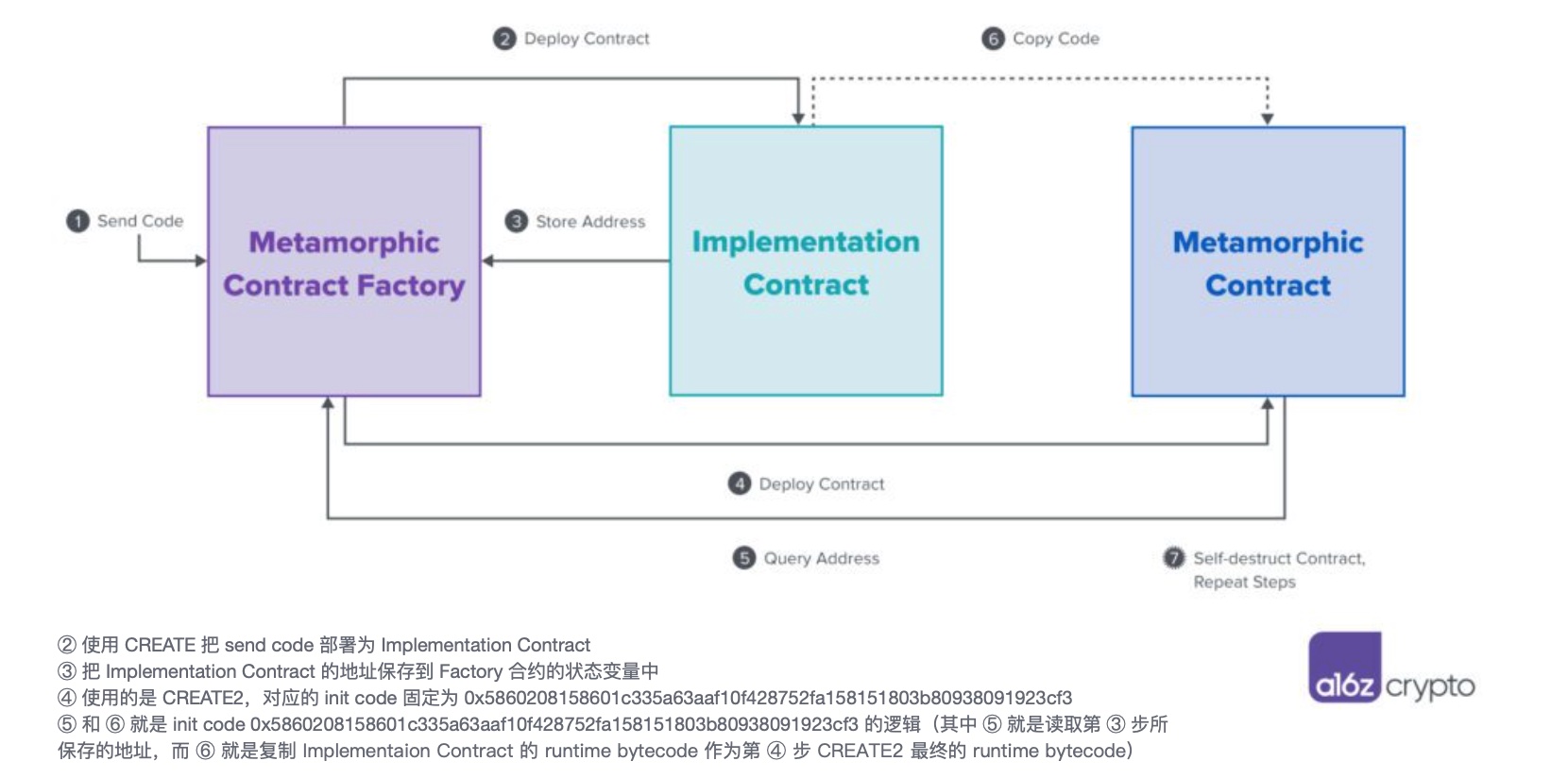如何在同样的地址上部署不同的合约
- cig01
- 发布于 2024-11-04 11:38
- 阅读 2310
如何在同样的地址上部署不同的合约
1. 问题介绍
在以太坊中,智能合约 Contract1 部署到链上后,得到地址 Addr1,我们知道在智能合约 Contract1 中调用 SELFDESTRUCT(注:SELFDESTRUCT 目前已经标记为 deprecated 了)可以销毁智能合约 Contract1。请问:地址 Addr1 上的智能合约 Contract1 销毁以后,我们还可以在地址 Addr1 上部署另一个智能合约 Contract2 吗?答案是肯定的,本文将介绍两种方法。
1.1. CREATE 和 CREATE2
在进入本文主题之前,我们先介绍一些背景知识。
以太坊上有两种方式可以创建智能合约:CREATE 和 CREATE2。
CREATE 部署的智能合约,其地址计算公式为:
keccak256(rlp_encode(sender, nonce))[12:]其中 sender 可以是 EOA,也可以是智能合约。
-
当 sender 是 EOA 帐户时,调用 RPC eth_sendTransaction(指定
to为 null,data为合约的 init code)可部署智能合约。 -
当 sender 是智能合约时,在 Solidity 中使用关键字
new可部署智能合约,如new Contract1(),这种方式部署的合约会按照 CREATE 的规范得出地址。
CREATE2 部署的智能合约,其地址计算公式为:
keccak256(0xff ++ deployer_addr ++ salt ++ keccak256(init_code))[12:]如果在智能合约中使用 new 关键字部署另一智能合约时指定了 salt 选项(不指定 salt 选项时是按照 CREATE 规则得到新地址),则部署的新合约会按照 CREATE2 的规范来得出新地址。比如 new Contract1{salt: salt}() 。
1.1.1. init code 和 runtime bytecode
在合约部署时,会涉及到两种 bytecode:
-
init code (creation bytecode)。比如 RPC eth_sendTransaction 的 data 字段就是 init code;CREATE2 的参数中也有 init code;
-
runtime bytecode (deployed bytecode)。合约部署时会运行 init code,而 init code 的结果就是 runtime bytecode。使用 EXTCODECOPY 可以复制合约的 runtime bytecode。
2. 方法一:CREATE(重置 nonce 为 1)
前面介绍过,使用 CREATE 部署合约,合约的地址只和 sender 和 nonce 值有关:
-
如果 sender 是 EOA 地址,那么 EOA 的 nonce 值是自增的,这样使用同一个 sender 每次部署合约时所使用的 nonce 值都会不一样,所以 EOA 地址没有办法使用 CREATE 部署合约到一个以前存在的地址中。
-
如果 sender 是智能合约地址(记为 deployer),它的 nonce 值也是自增的(EIP161 规定了从 1 开始自增),但是 deployer 合约本身可以被销毁(SELFDESTRUCT), deployer 合约销毁后,它的 nonce 值会被重置为 1, 我们可以使用 CREATE2 重新部署同一个 deployer 合约(合约相同,地址也相同)。这样,每次 deployer 被重新部署时,在 deployer 合约中通过 CREATE 部署的第一个合约,由于 nonce 值每次都是 1,所以其地址一定都相同。
举例来说,如果下面的 Contract10/Contract11/Contract12/Contract20/Contract21/Contract22 都是由 deployer 合约使用 CREATE 部署,则 Contract10/Contract11/Contract12 地址分别会和 Contract20/Contract21/Contract22 地址相同。
deployer
Contract10 # nonce=1, addr(Contract10) = keccak256(rlp_encode(deployer_addr, nonce=1))[12:]
Contract11 # nonce=2, addr(Contract11) = keccak256(rlp_encode(deployer_addr, nonce=2))[12:]
Contract12 # nonce=3, addr(Contract12) = keccak256(rlp_encode(deployer_addr, nonce=3))[12:]
deployer (reset nonce to 1)
Contract20 # nonce=1, addr(Contract20) = keccak256(rlp_encode(deployer_addr, nonce=1))[12:]
Contract21 # nonce=2, addr(Contract21) = keccak256(rlp_encode(deployer_addr, nonce=2))[12:]
Contract22 # nonce=3, addr(Contract22) = keccak256(rlp_encode(deployer_addr, nonce=3))[12:]下面例子演示了如何利用重置 nonce 的方式来实现“部署一个不同合约到被销毁的合约地址上”:
// SPDX-License-Identifier: MIT
contract DeployerDeployer {
event Log(address addr);
function deploy() external {
bytes32 salt = keccak256(abi.encode(uint(123)));
address addr = address(new Deployer{salt: salt}()); // 这是 CREATE2 方式,部署出来的地址和 deployer_addr(即 DeployerDeployer 地址), salt, init_code 有关
emit Log(addr);
}
}
contract Deployer {
event Log(address addr);
function deployContract1() external {
address addr = address(new Contract1()); // 部署出来的地址和 deployer_addr 和 nonce 有关
emit Log(addr);
}
function deployContract2() external {
address addr = address(new Contract2()); // 部署出来的地址和 deployer_addr 和 nonce 有关
emit Log(addr);
}
function kill() external {
selfdestruct(payable(address(0)));
}
}
contract Contract1 {
function f1() public pure returns (uint) {
return 1;
}
function kill() external {
selfdestruct(payable(address(0)));
}
}
contract Contract2 {
function f2() public pure returns (uint) {
return 2;
}
function kill() external {
selfdestruct(payable(address(0)));
}
}测试步骤:
-
部署 DeployerDeployer 合约;
-
调用 DeployerDeployer 合约的 deploy 方法来部署 Deployer 合约,记部署后的 Deployer 合约的地址为 AddrD;
-
调用 Deployer 合约的 deployContract1 方法来部署 Contract1 合约,记部署后 Contract1 合约的地址为 Addr1;
-
调用 Deployer 合约的 kill 方法来销毁 Deployer 合约,目的是重置 Deployer 合约的 nonce 值为 1;
-
调用 Contract1 合约的 kill 方法来销毁 Contract1 合约,目的清掉 Addr1 上的合约 Contract1;
-
调用 DeployerDeployer 合约的 deploy 方法来重新部署 Deployer 合约,部署后的 Deployer 合约的地址一定为 AddrD;因为 Deployer 合约是使用 CREATE2 来部署的,salt 是写死的,两次部署 Deployer 合约时没有变。
-
调用 Deployer 合约的 deployContract2 方法来部署 Contrac2 合约,部署后 Contrac2 合约的地址也一定为 Addr1。因为 Contrac2 合约是使用 CREATE 来部署的,deployer_addr 没有变(和部署 Contract1 时一样,都是同一个 Deployer 来部署的),而 nonce 也没有变(都是 1)。
2.1. 重置 nonce 值总结
前面介绍的过程可以总结为图 1 所示。
Figure 1: 利用重置 nonce 值部署不同合约到相同地址上(合约 Contract1 和 Contract2 不同,但它们地址相同)
2.2. 黑客攻击 Tornado Cash DAO
2023 年 05 月 21 日,黑客利用前面介绍的这种重置 nonce 值的方式成功攻击了 Tornado Cash DAO,一个 DAO 提案主要有提交/投票/执行三个过程。黑客的攻击思路是:提交提案时使用是的 Contract1,而当提案被投票通过后,在执行提案之前把 Contract1 销毁了,黑客部署了另一个恶意合约 Contract2 到提案所在地址(即之前的 Contract1 地址)上,这样执行提案相当于执行 Contract2 中代码了。这里有个简单的 POC:<https://solidity-by-example.org/hacks/deploy-different-contracts-same-address/>
3. 方法二:CREATE2(Metamorphic Contract Pattern)
利用 Metamorphic Contract Pattern 可以实现一个地址上部署不同的合约。
Metamorphic Contract 的基本原理是: 使用 CREATE2 部署合约,init code 不变(这样可以保证 CREATE2 产生的地址不变),但这个 init code 在不同时期执行会产生不同的 runtime bytecode。
3.1. Metamorphic 合约实例
//SPDX-License-Identifier: MIT
pragma solidity 0.8.1;
contract Factory {
mapping (address => address) _implementations;
event Deployed(address _addr);
function deploy(uint salt, bytes calldata bytecode) public {
bytes memory implInitCode = bytecode;
// assign the initialization code for the metamorphic contract.
bytes memory metamorphicCode = (
hex"5860208158601c335a63aaf10f428752fa158151803b80938091923cf3"
);
// determine the address of the metamorphic contract.
address metamorphicContractAddress = _getMetamorphicContractAddress(salt, metamorphicCode);
// declare a variable for the address of the implementation contract.
address implementationContract;
// load implementation init code and length, then deploy via CREATE.
/* solhint-disable no-inline-assembly */
assembly {
let encoded_data := add(0x20, implInitCode) // load initialization code.
let encoded_size := mload(implInitCode) // load init code's length.
implementationContract := create( // call CREATE with 3 arguments.
0, // do not forward any endowment.
encoded_data, // pass in initialization code.
encoded_size // pass in init code's length.
)
} /* solhint-enable no-inline-assembly */
//first we deploy the code we want to deploy on a separate address
// store the implementation to be retrieved by the metamorphic contract.
_implementations[metamorphicContractAddress] = implementationContract;
address addr;
assembly {
let encoded_data := add(0x20, metamorphicCode) // load initialization code.
let encoded_size := mload(metamorphicCode) // load init code's length.
addr := create2(0, encoded_data, encoded_size, salt)
}
require(
addr == metamorphicContractAddress,
"Failed to deploy the new metamorphic contract."
);
emit Deployed(addr);
}
/**
* @dev Internal view function for calculating a metamorphic contract address
* given a particular salt.
*/
function _getMetamorphicContractAddress(
uint256 salt,
bytes memory metamorphicCode
) internal view returns (address) {
// determine the address of the metamorphic contract.
return address(
uint160( // downcast to match the address type.
uint256( // convert to uint to truncate upper digits.
keccak256( // compute the CREATE2 hash using 4 inputs.
abi.encodePacked( // pack all inputs to the hash together.
hex"ff", // start with 0xff to distinguish from RLP.
address(this), // this contract will be the caller.
salt, // pass in the supplied salt value.
keccak256(
abi.encodePacked(
metamorphicCode
)
) // the init code hash.
)
)
)
)
);
}
// getImplementation() 的函数 selector 为 0xaaf10f42,它会被代码 5860208158601c335a63aaf10f428752fa158151803b80938091923cf3 所调用
function getImplementation() external view returns (address implementation) {
return _implementations[msg.sender];
}
}
contract Test1 {
uint public myUint;
function setUint(uint _myUint) public {
myUint = _myUint;
}
function killme() public {
selfdestruct(payable(msg.sender));
}
}
contract Test2 {
uint public myUint;
function setUint(uint _myUint) public {
myUint = 2*_myUint;
}
function killme() public {
selfdestruct(payable(msg.sender));
}
}下面是使用步骤:
-
部署 Factory 合约;
-
调用 Factory 合约的 deploy 方法部署 Test1,deploy 的第 1 个参数设置为 salt=1(不一定是 1,和第 4 步时使用的 salt 值一样就行),第 2 个参数设置为 bytecode=Test1's bytecode; deploy 的主要逻辑是:先使用 CREATE 部署 deploy 的第 2 个参数传入的 bytecode(比如这次就是 Test1 的 bytecode),然后把部署后的地址写入到状态变量 _implementations 中,最后调用 CREATE2 完成部署(指定的 init code 固定为 0x5860208158601c335a63aaf10f428752fa158151803b80938091923cf3),CREATE2 部署后的地址就是最终 Test1 的部署地址。 从 deploy 方法执行时发出的 event Deployed 中可以得到 Test1 的部署地址;
-
调用 Test1 的 killme 方法,可以销毁 Test1 合约;
-
调用 Factory 合约的 deploy 方法部署 Test2,deploy 的第 1 个参数设置为 salt=1,第 2 个参数设置为 bytecode=Test2's bytecode;从 deploy 方法执行时发出的 event Deployed 中可以得到 Test2 的部署地址;
-
我们可以验证两次调用 deploy 方法时,从 event Deployed 中得到的地址相同。也就是说 Test1 和 Test2 尽管逻辑不同,但它们的地址却相同。
读者可能有个疑问,在第 2 步和第 4 步中使用 CREATE2 来部署合约时,所使用的 init code 是相同的(即上面代码中的 0x5860208158601c335a63aaf10f428752fa158151803b80938091923cf3)。为什么这个 init code 即可生成 Test1 的 runtime code,又可生成 Test2 的 runtime code 呢?下一节将介绍。
3.2. init code(metamorphicCode)
Init code 0x5860208158601c335a63aaf10f428752fa158151803b80938091923cf3(共 29 字节)的每个字节的具体说明可以参考:<https://etherscan.io/address/0x00000000e82eb0431756271f0d00cfb143685e7b#code>
为了说明方便,下面摘录如下:
/**
* @dev In the constructor, set up the initialization code for metamorphic
* contracts as well as the keccak256 hash of the given initialization code.
* @param transientContractInitializationCode bytes The initialization code
* that will be used to deploy any transient contracts, which will deploy any
* metamorphic contracts that require the use of a constructor.
*
* Metamorphic contract initialization code (29 bytes):
*
* 0x5860208158601c335a63aaf10f428752fa158151803b80938091923cf3
*
* Description:
*
* pc|op|name | [stack] | <memory>
*
* ** set the first stack item to zero - used later **
* 00 58 getpc [0] <>
*
* ** set second stack item to 32, length of word returned from staticcall **
* 01 60 push1
* 02 20 outsize [0, 32] <>
*
* ** set third stack item to 0, position of word returned from staticcall **
* 03 81 dup2 [0, 32, 0] <>
*
* ** set fourth stack item to 4, length of selector given to staticcall **
* 04 58 getpc [0, 32, 0, 4] <>
*
* ** set fifth stack item to 28, position of selector given to staticcall **
* 05 60 push1
* 06 1c inpos [0, 32, 0, 4, 28] <>
*
* ** set the sixth stack item to msg.sender, target address for staticcall **
* 07 33 caller [0, 32, 0, 4, 28, caller] <>
*
* ** set the seventh stack item to msg.gas, gas to forward for staticcall **
* 08 5a gas [0, 32, 0, 4, 28, caller, gas] <>
*
* ** set the eighth stack item to selector, "what" to store via mstore **
* 09 63 push4
* 10 aaf10f42 selector [0, 32, 0, 4, 28, caller, gas, 0xaaf10f42] <>
*
* ** set the ninth stack item to 0, "where" to store via mstore ***
* 11 87 dup8 [0, 32, 0, 4, 28, caller, gas, 0xaaf10f42, 0] <>
*
* ** call mstore, consume 8 and 9 from the stack, place selector in memory **
* 12 52 mstore [0, 32, 0, 4, 0, caller, gas] <0xaaf10f42>
*
* ** call staticcall, consume items 2 through 7, place address in memory **
* 13 fa staticcall [0, 1 (if successful)] <address>
*
* ** flip success bit in second stack item to set to 0 **
* 14 15 iszero [0, 0] <address>
*
* ** push a third 0 to the stack, position of address in memory **
* 15 81 dup2 [0, 0, 0] <address>
*
* ** place address from position in memory onto third stack item **
* 16 51 mload [0, 0, address] <>
*
* ** place address to fourth stack item for extcodesize to consume **
* 17 80 dup1 [0, 0, address, address] <>
*
* ** get extcodesize on fourth stack item for extcodecopy **
* 18 3b extcodesize [0, 0, address, size] <>
*
* ** dup and swap size for use by return at end of init code **
* 19 80 dup1 [0, 0, address, size, size] <>
* 20 93 swap4 [size, 0, address, size, 0] <>
*
* ** push code position 0 to stack and reorder stack items for extcodecopy **
* 21 80 dup1 [size, 0, address, size, 0, 0] <>
* 22 91 swap2 [size, 0, address, 0, 0, size] <>
* 23 92 swap3 [size, 0, size, 0, 0, address] <>
*
* ** call extcodecopy, consume four items, clone runtime code to memory **
* 24 3c extcodecopy [size, 0] <code>
*
* ** return to deploy final code in memory **
* 25 f3 return [] *deployed!*
*
*
* Transient contract initialization code derived from TransientContract.sol.
*/总结一下它的主要逻辑:
-
调用 msg.sender 中的方法 getImplementation()(它对应的函数 selector 为 0xaaf10f42)可得到一个地址,记为 Impl 合约;
-
利用 extcodecopy 把 Impl 合约的 runtime bytecode 复制到 memory 中,这样作为 CREATE2 部署合约的 runtime bytecode。
如果 init code 0x5860208158601c335a63aaf10f428752fa158151803b80938091923cf3 中调用 getImplementation() 时得到的地址不一样,那么 extcodecopy 复制的 runtime bytecode 就不一样。这就是相同 init code 可部署出不同的 runtime bytecode 的关键。
3.3. Metamorphic Contract 总结
Metamorphic Contract 的总结如图 2 所示(摘自:<https://a16zcrypto.com/posts/article/metamorphic-smart-contract-detector-tool> )。
Figure 2: Metamorphic Contract 总结
两次部署(第一次部署完,调用 selfdestruct 后再进行第二次部署)时,由于使用的 init code 相同都是 0x5860208158601c335a63aaf10f428752fa158151803b80938091923cf3,所以 CREATE2 得到的地址一样(当然也要求两次部署时的 deployer_addr 和 salt 都一样,不过这很容易满足);两次部署时,③ 保存的地址不一样,从而 ⑤ 所得到的地址不一样,从而 ⑥ 复制的 runtime bytecode 不一样,从而 CREATE2 所部署合约的 runtime code 不一样。
4. 参考
-
https://solidity-by-example.org/hacks/deploy-different-contracts-same-address
-
https://ethereum-blockchain-developer.com/110-upgrade-smart-contracts/12-metamorphosis-create2/
-
https://a16zcrypto.com/posts/article/metamorphic-smart-contract-detector-tool
作者: cig01, 原文链接:https://aandds.com/blog/eth-different-contracts-same-address.html
- 工厂模式 - 智能合约如何部署其他合约 242 浏览
- 部署与确定性地址(CREATE vs CREATE2) 900 浏览
- 理解合约部署、代理和CREATE2——第二部分 2674 浏览
- 利用Wake的引导模糊测试检测抢跑漏洞 1045 浏览
- 理解合约部署、代理和CREATE2——第一部分 1100 浏览
- 以太坊地址的推导方式(EOA、CREATE 和 CREATE2) 2237 浏览
- 实用工具 - OpenZeppelin 文档 1185 浏览
- ERC-7955 提案:无需私钥的 CREATE2 工厂 434 浏览
- 用于无需许可的合约工厂的多链部署流程 - ERC 463 浏览
- 枚举所有 69,788,231 个以太坊合约 998 浏览
- 以太坊进阶操作 - 合约调用、地址预测、发送与接收 ETH 2169 浏览
- Web3智能合约 -- create2 底层原理与实现机制 1397 浏览



